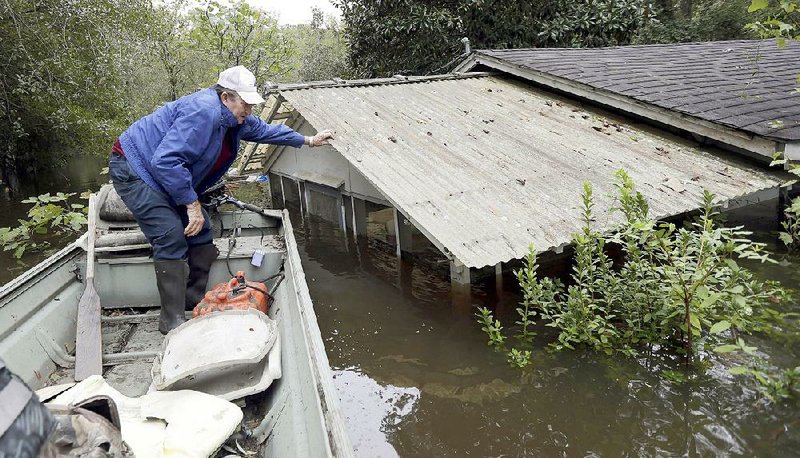COLUMBIA, S.C. -- Owners of inundated homes were keeping close watch on swollen waterways Tuesday as they pried open doors and tore out soaked carpets on the first sunny day in nearly two weeks.
So far, at least 17 people have died in the floods in the Carolinas, some of them drowning after trying to drive through high water.
Tuesday was the first dry day since Sept. 24 in South Carolina's state capital, where a midnight-to-6 a.m. curfew was in effect. But officials warned that new evacuations could come as the mass of water flows toward the sea, threatening dams and displacing residents along the way.
Of particular concern was the Lowcountry, where the Santee, Edisto and other rivers make their way to the sea. Gov. Nikki Haley warned that several rivers were rising and had yet to reach their peaks.
"God smiled on South Carolina because the sun is out. That is a good sign, but ... we still have to be cautious," Haley said Tuesday after taking an aerial tour. "What I saw was disturbing.
"We are going to be extremely careful. We are watching this minute by minute."
Georgetown, one of America's oldest cities, sits on the coast at the confluence of four rivers. The historic downtown flooded over the weekend, and its ordeal wasn't over yet.
"It was coming in through the kitchen wall, through the bathroom walls, through the bedroom walls, through the living room walls. It was up over the sandbags that we put over the door. And, it just kept rising," resident Tom Doran said. "If I see a horde of locusts, then I'm taking off."
In Effingham, east of Columbia, the Lynches River was at nearly 20 feet Tuesday -- 5 feet above flood stage. Kip Jones paddled a kayak to check on a home he rents out there, and he discovered that the family lost pretty much everything it had, with almost 8 feet of standing water in the bedrooms.
"Their stuff is floating all in the house," Jones said. "Once the water comes in the house, you get bacteria and you get mold."
In downtown Columbia, about 200 workers rushed to fix a breach in a canal that was threatening the city's water supply to its 375,000 customers. The city's main intake valve is in the canal, and the water level was steadily dropping, Columbia Utilities Director Joey Jaco said.
Crews planned to work into this morning, sinking a barge and piling bags of rocks and sand on top to try and block the hole in the canal, Jaco said.
If the water gets below the intake value, there is less than a day's supply in a reservoir.
"We need to make sure we get this dam constructed very soon to make sure we stay above a minimal level," Jaco said.
Haley said it was too soon to estimate the damage, which could be "any amount of dollars." The Republican governor quickly got a federal disaster declaration from President Barack Obama, freeing up money and resources. Sen. Lindsey Graham, R.-S.C. and a presidential candidate, promised not "to ask for a penny more than we need" and criticized other lawmakers for seeking financing for unrelated projects in disaster bills.
Water distribution was a challenge. In the region around Columbia, as many as 40,000 homes lacked drinking water, and Mayor Steve Benjamin said 375,000 water customers will likely have to boil their water before drinking or cooking for "quite some time."
The power grid was returning to normal after nearly 30,000 customers lost electricity. Roads and bridges were taking longer to restore: Some 200 engineers were inspecting about 470 spots that remained closed Tuesday, including a 75-mile stretch of Interstate 95.
South Carolina was soaked by what experts at the National Oceanic and Atmospheric Administration called a "fire hose" of tropical moisture spun off by Hurricane Joaquin, which mostly missed the East Coast.
Authorities have made hundreds of water rescues since then, lifting people and animals to safety. About 800 people were in two dozen shelters, but the governor expects that number to rise.
In Columbia, Ray Stilwell told a harrowing story of escaping his home along Gills Creek, where nearly 17 inches fell in as many hours Sunday.
He was upstairs when his back door failed and water rushed in, and he was nearly swept away as he tried to make it outside to higher ground. He survived by hanging on to a neighbor's gate, then climbing atop a patio table.
"I'm so grateful. If you hear me complain, remind me that I'm lucky to be here," the 59-year-old schoolteacher said. "God allowed me to be here; now I've just got to figure out what to do with the extra time I've been given."
Stilwell took a long look at the nearby creek, which was still raging and foamy but didn't seem to be rising. A worried neighbor called out, asking what was going on.
"Just keep watching the water level right now," Stilwell responded.
Information for this article was contributed by Bruce Smith, Alex Sanz, Susanne M. Schafer, Jeffrey Collins, Meg Kinnard and Seth Borenstein of The Associated Press.
A Section on 10/07/2015


